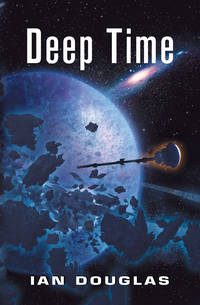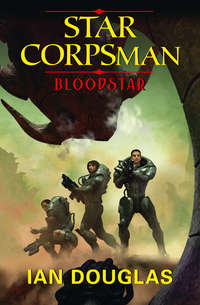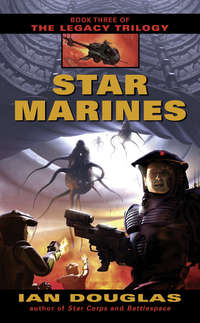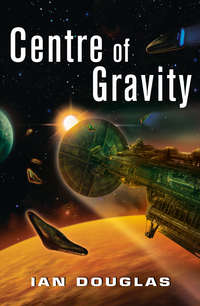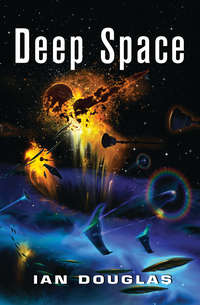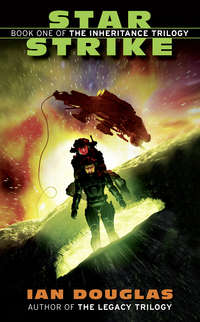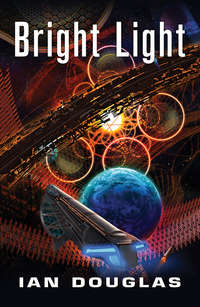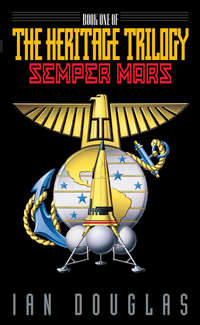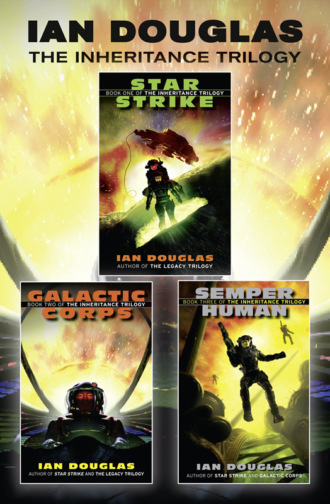
Полная версия
The Complete Inheritance Trilogy: Star Strike, Galactic Corps, Semper Human
They were civilians, obviously. The Islamic Theocracy did not permit female soldiers, and there’d been children down there as well. Clearly, they’d been trying to find shelter inside the basement.
Equally clearly, the deaths had been inflicted by Theocrat weapons; the assault force had not employed nano-D.
It was said that the life expectancy of an unarmored person on a modern battlefield was measured in scant seconds. These people had never had a chance. Ramsey felt a sullen rage growing within—rage at the Muzzies for their blind use of indiscriminate weaponry and their placement of military targets close beside civilian enclaves, rage at the op planners who’d targeted a heavily inhabited planet, rage at the very idea of war, of doing this to innocent bystanders.
Turning away, finally, he grasped Chu’s elbow and steered him clear of the scene.
He didn’t think he was going to be able to get rid of the memory.
He wasn’t sure he wanted to.
And at the same time, he wasn’t certain he could live with the nightmare.
4
0507.1102
USMC Skybase
Paraspace
0946 hrs GMT
Lieutenant General Martin Alexander completed the final download encompassing the Alighan operation. Casualties had been God-awful high—almost twenty percent—and a disproportionate percentage of those were irretrievables, men and women so badly charred by heat or radiation or so melted by nano-D that they could not be brought back to life. Those were the tough ones, the ones requiring a virtual visit to parents or spouses.
With a mental click, he shifted his awareness to the Map Center, a noumenal chamber with a three-D navigable representation of the entire Galaxy. For a moment, his mind’s eye hovered above the broad, softly radiant spiral, taking in the nebulae-clotted spiral arms, pale blue and white, unwinding from the ruddier, warmer core, a vast and teeming beehive of suns surrounded by gas-cloud ramparts, like luminous thunderheads at the Core’s periphery. Four hundred billion stars across a spiral a hundred thousand light-years across.
How many of those pinpoint stars making up those banked, luminous clouds and streaming arms were suns, with worlds and life and civilizations?
An unanswerable question.
A majority of stars had planets, of course. That fact had been certain as far back as the twenty-first century or before, when extrasolar planets had first been discovered. Worlds with life were common as well; wherever there was liquid water or, more infrequently, liquid ammonia or liquid sulfur, life, of one kind or another, seemed to arise almost spontaneously.
How many of those worlds with life developed intelligence, however, and communicative civilizations, was a much more difficult, and darker question. Once, the answer would have been “millions” or even “tens of millions,” a guess based partly upon statistical analyses and partly upon xenoarcheological discoveries within the Solar System and elsewhere that showed technic civilization, starfaring civilization, exploding across the Galaxy in wave upon wave.
But that was before the discovery of the true nature of the Xul.
“General Alexander?”
“Yes, Herschel.”
Herschel was the artificial intelligence controlling the Galaxy display.
“Your aide wishes to link with you.
Damn. Never a moment’s peace. “Very well.”
Cara, his electronic assistant, entered his noumenal space, her EA icon materializing out of the void. “Excuse the interruption, General.”
“Whatcha got?”
“Sir, we have a final plot on the Argo. And a partial synch with the ship’s AI.”
“Only partial?”
“Whatever happened out there happened very quickly.”
“I see.” He sighed. “Okay. Feed it through. And let’s see the plot.”
A white pinpoint winked brightly within the depths of one of the spiral arms. At the same time, he felt the surge of incoming data, an e-brief, only, representing the synch with the Argo’s AI.
Perseus. The name of the AI had been Perseus.
“A group of delegates from the Defense Advisory Council wants to link with you to discuss the Xul threat,” his aide continued as he skimmed the brief.
“I’ll just bet they do. Okay. When?”
“Fourteen minutes. Ten-hundred hours.”
“Huh. The Argo incident has them worried.”
“Terrified, more like it. And can you blame them, sir? There hasn’t been another peep out of the Xul for five hundred years.”
Alexander completed the brief, then stared into the sea of teeming suns hanging before him. “I wouldn’t call the bombardment of Earth by high-velocity asteroids a ‘peep,’ Cara. Earth was nearly destroyed.”
“Yes, sir. But they didn’t finish us. In fact, they seem to have lost track of us entirely.”
“Garroway’s attack at Night’s Edge—” He stopped himself. He had a tendency, he knew, to slip into lecture mode, and his aide knew the history of Night’s Edge as well as he did. Better, perhaps.
“Exactly, sir,” she said. “Garroway gambled that information about our whereabouts in the Galaxy had not been disseminated yet beyond the Xul base that launched the attack on us. And apparently his gamble paid off. Only now …”
“Now the Xul appear to have picked up the trail again.”
“We have to assume that if they captured the Argo, they know where we are. And they’ll be better prepared next time. Stronger, more careful, and in greater numbers.”
“We damned near didn’t survive their last attack,” Alexander pointed out. “And that was just one Xul huntership!”
In the year 539 of the Marine Era, or in 2314 c.e. as the Commonwealth measured the passing years, a single kilometer-long Xul vessel had appeared out of the emptiness between the stars, destroyed several human ships, then proceeded to fling small chunks of asteroidal debris at the Earth. The fragments were small, but somehow the Intruder had boosted them to very high velocities—on the order of half the speed of light—giving them the kinetic energy of much larger bodies when they struck.
Deep space facilities designed as part of the High Guard asteroid defense network had succeeded in destroying many of the infalling rocks, but enough pieces had struck Earth to do terrible damage, obliterating much of Europe and eastern North America in firestorms and tidal waves and plunging the rest of the planet into an ice age—what the histories persisted in calling a “nuclear winter,” even though the impacts were purely kinetic, and not nuclear at all.
The only thing that had saved civilization from complete collapse had been the fact that Humankind possessed a considerable off-world presence—numerous space stations, factories, colonies, and military bases in Earth orbit, on Luna and Mars, in the Asteroid Belt, and farther out, among the satellites of Jupiter. Billions died on the Motherworld, first in the holocaust of falling debris, then of starvation and exposure as the snows deepened and the oceans began icing over. But technological help had begun pouring in from the space-based colonies, especially from the orbital nanufactories, untouched by the devastation wrought on Earth. Nanufactured food, power plants, and constructors had been loaded into immense one-trip gliders by the megaton and deorbited for recovery in the ice-free equatorial zones of Earth’s oceans. Within another century, one, then dozens of space elevators had been lowered into place, connecting points along the equator with matching points in geostationary orbit, after which the supplies had really begun flowing down the pipelines from space. Ground-based agricultural nanufactories had begun producing food locally, then, along with nano designed to break down ice, lower the skyrocketing planetary albedo, and clean up the detritus of a wrecked technic civilization.
Slowly, then, the recovery had begun.
And five centuries later, that recovery was continuing. New cities were growing now along the shockingly altered Atlantic coastlines. Most of the gangs and local warlords had long since been suppressed, or incorporated into the new government. North America and most of Europe were no longer dependent on supplies from space.
Of course, the former United States was now a special protectorate of the Commonwealth, a necessary adjustment in the face of the aggressive expansion of the Chinese Hegemony. And the Islamic Theocracy continued to be a perennial problem, ruled from the Principiate of Allah, at Mecca. Sharp wars had been fought with both states to protect both the Americas and Europe.
Alexander allowed himself an inner, unvocalized sigh. The real enemy, as always, remained the Xul, and for half a millennium Humankind had continued its divided, petty squabblings among its various fragmented religious, political and economic factions. This current unpleasantness with the Theocracy was only the latest in eight hundred years of bloodshed that stretched all the way back to WWIII, and which some historians insisted went back even further, to the Crusades of the Middle Ages.
Still adrift just above the galactic plane, Alexander gave a mental command and allowed his mind’s eye to descend into the sea of stars, moving out toward the spiral arms, toward one spur of a spiral arm in particular, about 23,000 light-years from the center. The vast majority of the stars in this simulation were approximations only, with no hard information about the stars or the worlds that might be circling them. Some day, perhaps … but for now Humankind’s knowledge of its celestial neighborhood was sharply restricted to an unevenly shaped blot perhaps 800 light-years across in its longest dimension, less than one percent of the vast and pinwheeling whole.
Ahead, the stars embraced by the Commonwealth and the other governments of Humankind glowed within a soft, green haze of light. Individual star systems were labeled with alphanumerics giving names and provenance—with Sol imbedded roughly at the center. Another mental click, and the green light fragmented into various shades of yellow, blue, and green, identifying the Islamic Arm, the Chinese Arm, the Pan-European Arm, the Latino Arm, the Commonwealth, and the rest.
He brought up a red icon marking the position of the lost Argo … 500 light-years from Sol, and on a direct line with the Andromedan Galaxy. She’d been well outside of human space when the Xul had discovered her; the outer fringes of Islamic space lay a light-century or so in her wake.
Orange pinpoints marked those outposts and garrisons of the Xul that had been identified over the past few hundred years, a fuzzy and diffuse cloud outside of human space; none lay close to Argo’s outbound route, but that was scarcely surprising. The Xul empire spanned the Galaxy and stretched well beyond it; Humankind thus far had identified only a few hundred Xul outposts and bases, and the best guess suggested that the Xul held a million star systems, or more.
“We now have a candidate star for another Xul base,” Herschel whispered in Alexander’s ear. “Here …”
A star was highlighted in blue, and Alexander zoomed in on it. Nu Andromedae, a type B5 V blue-white sun some 440 light-years from Earth. From Earth’s perspective, the star by chance appeared just to the east of M-31.
“The Argo must have passed quite close to Nu Andromedae,” Herschel added. The AI painted a red contrail streaming from the Argo, like a thin, taut thread stretching all the way back to Sol, and the line skimmed past Nu Andromedae, almost touching it. “Less than three light-years, in fact.”
“Maybe. But that was still over a hundred years ago. Why should the Xul wait that long before pouncing?”
“For the same reason the Xul have not found Earth, General. The term once in use was ‘a needle in a haystack.’”
Alexander had never seen either a sewing needle or a haystack, but the phrase was descriptive enough in its own right. Even the Xul, powerful and technologically advanced as they were, couldn’t be everywhere, couldn’t watch every star system or world where life might have evolved. The Galaxy was far too large for that level of omnipotence, even for beings with powers indistinguishable from those of gods.
“Herschel’s right, General,” his aide pointed out. “The Argo was a hollowed-out asteroid. Its passengers were in deep cybe-hibe. Even at close to the speed of light, it wouldn’t have been giving off much in the way of anomalous radiation.”
“I don’t buy it, Cara. We know now it would have been giving off a kind of wake as it plowed through the dust and hydrogen atoms floating around in its path—the interstellar medium. We can detect that sort of thing ourselves. If we can do it, the Xul can as well.” He studied the display a moment longer, rotating the display and studying the contrail. “Herschel … check distances from the contrail to nearby stars, and correlate with the one-way time lags. Assume radio noise expands from the Argo at the speed of light, and a more or less immediate response from the target star once the RF wave front reaches it.”
“Yes, General.” Angles and geometric designs flickered from star to star, touching the contrail at various points as the artificial intelligence searched for a better fit.
“Actually … that star is a better candidate,” Alexander said after a moment, indicating a particular geometry.
“Epsilon Trianguli,” Cara said, calling up the data window on the indicated star. “Type A2 V. Four hundred fifty light-years from Earth—”
“And 110 lights from the contrail at its closest passage,” Alexander said. “The Argo streaks by, disturbing the interstellar medium. The radio noise spreads out, like the wake of a boat on a calm lake, and reaches Epsilon Trianguli 110 years later. A Xul ship or base takes note and dispatches a force to investigate.”
“There are twenty-five other stars with corresponding distances, angles, and lag times,” Herschel told them, “albeit with lesser probabilities.”
“Store the data, Hersch,” Alexander said. “We may want to do a careful analysis, maybe even send a sneak-and-peek team out there for a look around.”
“Aye, aye, sir.”
For centuries, the Marines and Navy had dispatched scouting forces out from human space—sneak-and-peek teams, as they were popularly known—in order to try to identify specific stars where the Xul maintained a presence. The idea was that if Xul bases or colonies could be found, they could be watched, with an eye to noting any sudden activity that might presage a new assault against human space.
The sheer vastness of space, the grains-of-sand numbers of stars, worked both ways, however. For centuries, they’d hidden Sol from the Xul, protecting the existence of Humankind, but those same numbers allowed the vast majority of the Xul outposts to remain hidden as well.
But the further into interstellar space Humankind probed, the greater the chance, the more certain the inevitability, that it would once again trip the Xul sentries, as it had on several occasions already. And it seemed all but certain that, when the Xul returned to the Motherworld of Humankind, they would come with sufficient force to finish the job they’d begun several times before.
Humans had been lucky so far … lucky despite the fact that half a millennium ago Earth had so nearly been rendered uninhabitable. Only during the past few centuries had they begun piecing together the full history of human-Xul interactions, a relationship that extended back, it was believed, as far as half a million years.
As Cara and Herschel began preparing the virtual space for the electronic arrival of the Advisory Council, Alexander allowed his implant processors to cull through the data, reviewing past, present, and several darkly disturbing possible futures. As the data fell into place, he allowed himself a moment’s reverie, induced by the electronic flow from the local AI through the mingling of organic and inorganic regions of his brain.
Some five hundred thousand years ago, an advanced non-human intelligence—robotic intelligences unimaginatively dubbed variously the “Builders” or “the Ancients” by popular histories and the entertainment and news sims—had created an empire spanning all of today’s human space, and presumably extending far beyond. The Builders had terraformed Mars, and, for a brief time, at least, employed reasonably bright bipedal creatures imported from the third planet as workers—genetically altering them to boost their intelligence, and in doing so creating the species that later would call itself Homo sapiens.
But the Xul had attacked the Builders, however, the Xul or their militant predecessors. Ruins on Mars and on Earth’s Moon, on Chiron in the Alpha Centauri system, and on numerous other worlds attested to the violence and the completeness of the genocidal Xul campaign. One of their enormous ships, part machine and part downloaded intelligence, had been badly damaged in the conflict and crashed into the ice-locked world-ocean of Europa. The Builders, who called the invaders “The Hunters of the Dawn,” were destroyed, their empire reduced to broken ruins and rubble on a thousand far-strewn worlds. Of the Builders themselves, apparently, nothing had survived. Their genetically altered creations, however, had escaped the notice of the Xul, and survived, even flourished, on Earth.
Half a million years later, and some ten to fifteen thousand years ago, another spacefaring civilization had entered Earth’s Solar System. The An were in the process of establishing a much smaller, more modest interstellar empire, one embracing a few score star systems scattered across perhaps fifty light-years. They’d planted colonies on Earth and on Earth’s Moon, mined precious metals, and enslaved human nomads to raise food and work the mines. In making slaves, farms, and stone cities, they’d managed to become the prototypes of the gods and goddesses of ancient Mesopotamia. But then the An had attracted the notice of the Xul—the name itself had survived in the Sumerian language as one meaning “demon”—and the An, too, were annihilated.
The Xul had missed one Earthlike world populated by the An, however. The satellite of a gas giant well outside its sun’s habitable zone, perhaps it had been overlooked. On Ishtar, in the Lalande 21185 system eight and a half light-years from Sol, a few An and their human slaves had survived, remaining unnoticed in the holocaust when their technological infrastructure collapsed. On Earth, again, the An all were killed, but humans had survived to wonder about the cyclopean and monolithic ruins at places like Baalbek, submerged Yonaguni, and Tiahuanaco, and to tell stories of a universal deluge and the wrath of the gods.
Thousands of years passed, and humans on Earth again developed high technologies, this time on their own, and again they walked on other worlds. They found mysterious ruins on Mars and on Luna, and a few devices miraculously intact. They found the lost Xul ship, poetically dubbed “The Singer” for its eerie and insane radio transmissions, submerged deep beneath the Europan ice, and on Ishtar they found descendents of both An and humans.
From that time on, late in the twenty-second century, Humankind had existed in a kind of secretive balance with the Xul, who, it turned out, were still very much in existence after all those millennia. Like mice or cockroaches living in the walls of a very large dwelling, human starfarers sought to improve their own lot while avoiding the notice of the heavy-footed giants living nearby. Archeological teams spread out among the nearer star systems, seeking remnants of lost technologies left by the Builders, by the An, and by other civilizations. Eventually, another alien species had been discovered, the amphibian N’mah, living within an enigmatic Ancient-built stargate in the Sirius system.
In 2170, Marine and Navy forces at the Sirius Stargate had destroyed a Xul ship as it came through the Gate. In 2314, another Xul ship had appeared, this time within Earth’s solar system … and Earth had very nearly died. In 2323, a Navy-Marine task force had proceeded through the Sirius Gate to another, unknown and distant star system, Night’s Edge, using a freighter-load of sand scooped from the surface of Mars and accelerated to close to the speed of light to eliminate a Xul fleet and planetary base. As Cara had pointed out, the obliteration of that Xul outpost appeared to have wiped out any data the Xul had acquired pertaining to Humankind or Sol … and bought Earth a precious few more centuries to prepare for her next encounter with the Xul threat.
That there would be another encounter, Alexander had no doubt whatsoever. Since the early twentieth century, Earth had been broadcasting her presence; Sol now rested at the center of a sphere over 1,700 light-years across, a pulsing, restless bubble of electromagnetic radiation at radio wavelengths expanding outward at the speed of light—a certain indicator of intelligent, technic life at its center.
Alexander allowed himself a mental grin at the memory of an old joke. Perhaps it wasn’t an indicator of intelligent life, given the nature of much of the entertainment content of that bubble. Still, anyone with the appropriate technological know-how could hear that babble of noise, and know that technic civilization was responsible.
And The Singer had broadcast something to the stars back in 2067 when it was freed from its icy tomb. No, there was no way Humanity could keep its existence secret much longer.
And how was Humankind to survive in a contest against a technology half a million years more advanced?
It was a problem the Marine Corps had been struggling to resolve since the twenty-first century. So far, for the most part, they’d been able to fight isolated and tightly controlled battles, applying tactics that emphasized Marine strengths while sidestepping Xul technology. As commanding officer of the 1st Marine Interstellar Expeditionary Force, Alexander was responsible for keeping on top of the Xul threat, and keeping the Commonwealth government informed of any changes in the situation.
And the situation certainly had changed now, with the taking of the Argo.
“General?” Cara said, interrupting increasingly grim thoughts. “Will you want your full filters for the meeting?”
“Eh? What was that?”
“Your e-comm filters, sir. The delegates will begin linking in before too long. How do you want to be dressed?”
He grimaced. Personal filters were an important part of modern electronic communications. Within a noumenal setting—literally inside the participants’ heads—your personal icon could take on any appearance desired, anything within the programming range of the AIs giving the encounter substance. Filters allowed the image projected into the group mind’s virtual space to be of your own choosing, with apparent dress, body language, even inflection of voice under your control.
He didn’t like it, though. He never had. Though e-filters had been around for centuries, a necessary outgrowth of noumenal projection, they still seemed … dishonest, somehow, a kind of social white lie.
“You can’t,” Cara told him, a disapproving tone to her words, “receive the Defense Advisory Council like that.”
Mentally, he looked down at himself. As usual, he was projecting his real-world appearance into the galactic imagery … which, at the moment, was of a lean, middle-aged man with graying hair and a dour expression. He was also naked.
Causal nudity was perfectly acceptable within most modern social situations, but Cara was right. This was not the proper appearance to put before twenty-four of the more powerful and important of the arbiters of Commonwealth government policy.




